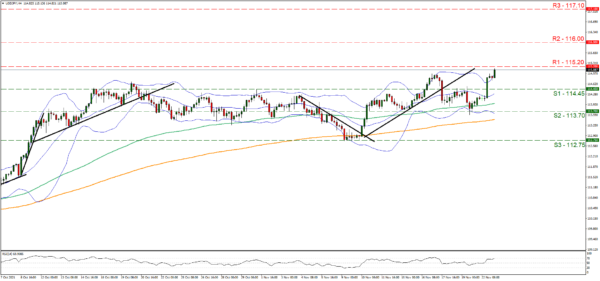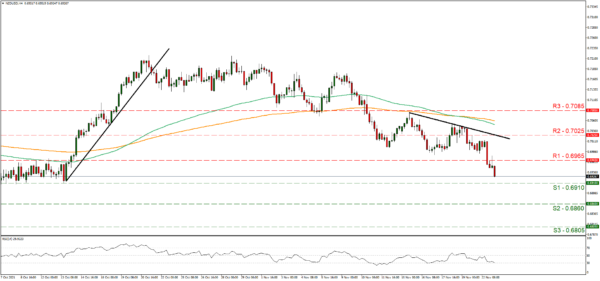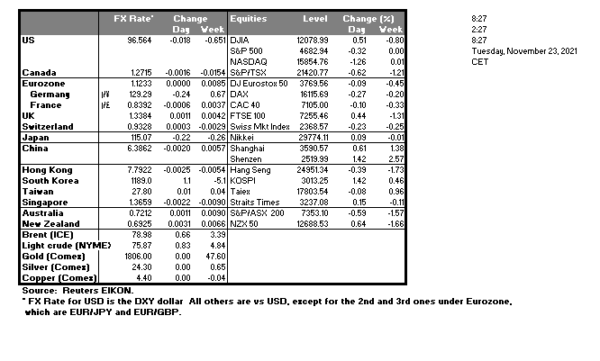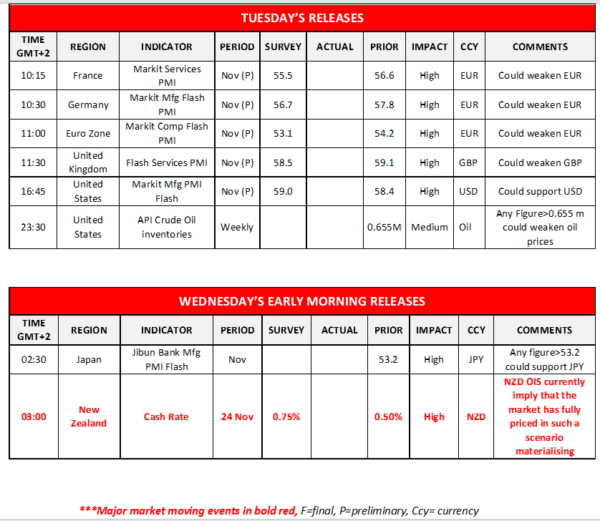The USD tended to gain against its counterparts yesterday as President Biden chose Jerome Powell for another term in the Fed’s highest post. The reappointment reaffirmed market expectations for a faster tightening of the bank’s monetary policy with rate hikes being possible next year. US stockmarkets tended to provide mixed reactions on the news yesterday, with S&P 500 and Nasdaq being in the reds for the day. As for financial releases we note the release of November’s US Markit preliminary PMI figures, which could provide some volatility for the USD, while the release of respective PMI readings for the Eurozone and the UK could also increase volatility for EUR and GBP pairs today. On the commodities front, we note the headlines by Reuters that the US is set to announce a release from government oil reserves in order to ease the pressure of a tight supply and to lower prices. Oil traders today may also turn their attention on the release of the API weekly crude oil inventories figure, and should another surplus be reported, we may see the bearish tendencies for oil prices intensifying.
USD/JPY rose yesterday aiming for the 115.20 (R1) line. The pair’s price action seems to have been moving in a sideways motion between the 115.20 (R1) resistance line and the 117.70 (S2) support line since the 15th of November. For our current sideways bias to change in favour of a bullish outlook we would require the pair to break clearly the 115.20 (R1) level. Please note that the RSI indicator below our 4-hour chart is near the reading of 70 implying a rather bullish sentiment. Should the bulls actually keep control over the pair’s direction, we may see it breaking the 115.20 (R1) line and aim for the 116.00 (R2) level. If the bears take over, we may see the pair reversing course, breaking the 114.45 (S1) support line and aim for the 113.70 (S2) level.
RBNZ to hike cash rate
On Wednesday’s Asian session we get from New Zealand RBNZ’s interest rate decision. The market currently has fully priced in the possibility of the bank hiking its cash rate by 25 basis points, raising it from 0.50% to 0.75%. It should be noted that since the last meeting of the bank which had resulted in a rate hike of 25 basis points, the CPI rate for Q3, has been released showing that inflation has accelerated reaching 4.9% yoy, but accelerated also on a quarter-on-quarter level. At the same time the employment market has tightened further for Q3, recovering somewhat from the blow caused by the pandemic. Should the bank actually proceed with a 25-basis points rate hike as its widely expected we may see the Kiwi getting some moderate support, as such a scenario may be allready priced in. If the bank proceeds with a rate hike and provide a warning that more rate hikes are yet to come, the support for the Kiwi may be greater, while in the scenario of a rate hike greater than 25 basis points, NZD may jump substantially. On the other hand, one should not underestimate the possibility of the bank remaining on hold, which could make the Kiwi tumble.
NZD/USD continued and even intensified its slide lower yesterday breaking the 0.6965 (R1) support line, now turned to resistance. We tend to maintain a bearish outlook for the pair given that the RSI indicator below our 4-hour chart is near the reading of 30 implying a bearish sentiment. On the other hand, we note that the pair’s direction may be affected heavily by RBNZ’s interest rate decision tomorrow during the Asian session. Should the pair find extended buying orders along its path we may see it reversing course and breaking the 0.6965 (R1) resistance line aiming for the 0.7025 (R2) level. Should the selling interest be maintained or even intensified we may see NZD/USD breaking the 0.6910 (S1) support line and aim for the 0.6860 (S2) level.
Other market highlights for today
Today we note the release of November’s preliminary Markit PMI readings for France, Germany, the Eurozone, UK and the US, while oil traders may be more interested in the release of the API crude oil inventories figure.
Support: 114.45 (S1), 113.70 (S2), 112.25 (S3)
Resistance: 115.20 (R1), 116.00 (R2), 117.10 (R3)
Support: 0.6910 (S1), 0.6860 (S2), 0.6805 (S3)
Resistance: 0.6965 (R1), 0.7025 (R2), 0.7085 (R3)

















